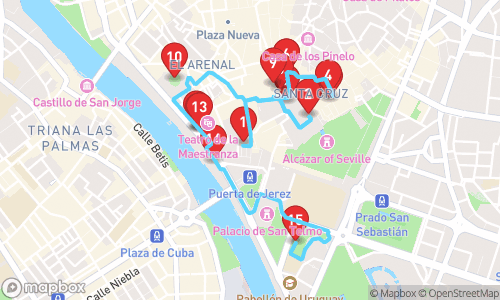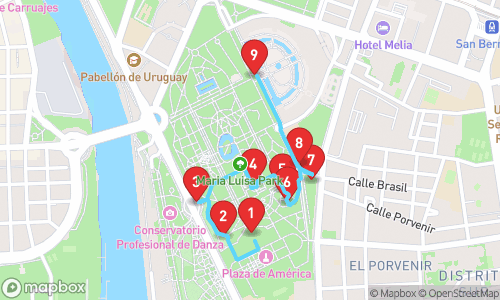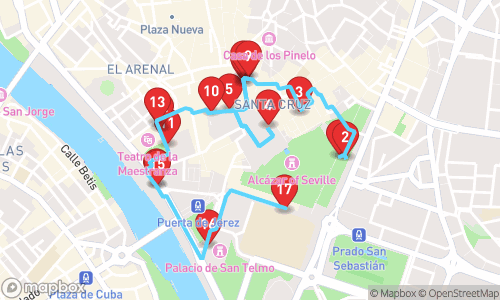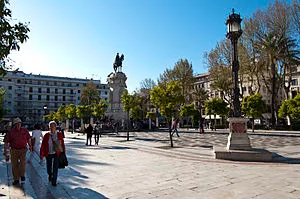
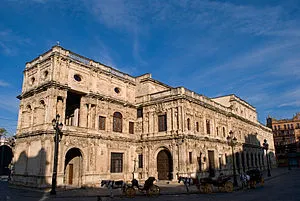
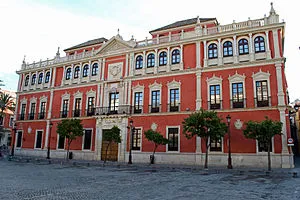
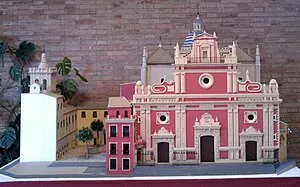
Sevilla: From Kings & Caliphs to Flamenco Rhythms

Tour Guide
Samuel L. Jackson
Welcome to Sevilla! On this GPS guided audio tour, we will visit 19 stops on a route of 2.53km. This tour focusses mainly on general tourism.
Locatello is an app where you can generate personal audio guided tours. Set your preferred distance, guide, language and theme, and a guided tour is created on the spot.
Walking Time
Distance
stops
Language
Tour Stops

Plaza Nueva
A public square in the city center of Seville, containing the city hall and featuring a Baroque Telefónica building, a monument to Fernando III, and the San Ofre Chapel, a remaining part of the former convent that occupied the plaza.

Cilly Hall of Sevilla
A Renaissance-style building housing the City Council of Seville, featuring a large façade with Plateresque reliefs, including grotesques, heraldic symbols, and depictions of mythological and historical characters.

Real Audiencia de Sevilla
A historic building housing the Real Audiencia de Sevilla, a former juridical organ of the Spanish Crown, now serving as the headquarters of the Fundación Cajasol.

Iglesia del Divino Salvador
A collegiate church, Iglesia del Divino Salvador is the second-largest church in Seville, featuring a Baroque edifice completed in 1712 after the original mosque was demolished and rebuilt.

Giralda
A striking bell tower, an iconic mixture of Moorish and Renaissance architecture in Seville, Spain, built as the minaret for the Great Mosque of Seville before being converted into a cathedral bell tower in the 16th century.
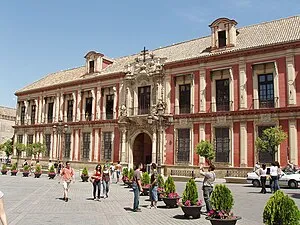
Archbishop's Palace
A palace in Seville, Spain, serving as the residence of bishops and archbishops, as well as nobleman and military figures, boasting a complex architectural style blending different styles, including Spanish Baroque, Mannerist, and Rococo.
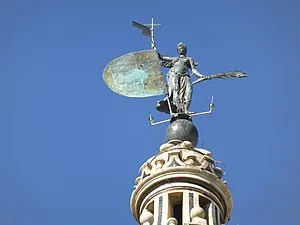
Giraldillo
A sculpture, specifically the alegory of Fe, triumph of the church, crowning the Giralda of Seville, created in 1568 by Bartolomé Morel.
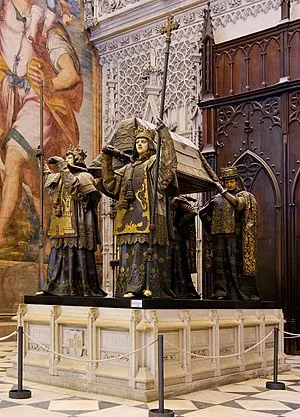
Tomb of Christopher Columbus (Seville)
A wooden tomb containing the remains of Christopher Columbus, a Spanish explorer and navigator who led the first European expeditions to the Americas. The tomb has been transferred several times during its history, including from Valladolid to Seville and from Santo Domingo to Havana.

Plaza del Triunfo
A baroque square featuring the Triunfo de Nuestra Señora del Patrocinio temple, built in 1757 to commemorate the 1755 Lisbon earthquake, and a monument to the Inmaculada Concepción, dedicated to four influential Sevillian figures.
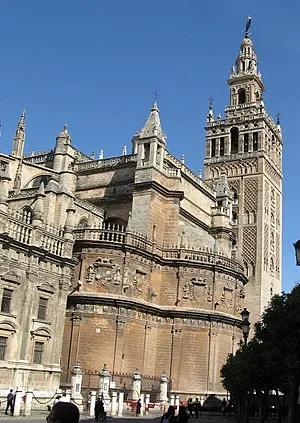
Catedral de Sevilla
Catholic cathedral in Seville, Andalusia, Spain, formerly a mosque, and a UNESCO World Heritage Site since 1987.

Teatro de la Maestranza
A historic opera house, Teatro de la Maestranza is a premier cultural venue in Spain, mainly hosting opera performances, as well as Zarzuela and other musical acts. The theatre is home to the Royal Seville Symphony Orchestra and the Choir of the Friends' Society of the Maestranza Theatre.
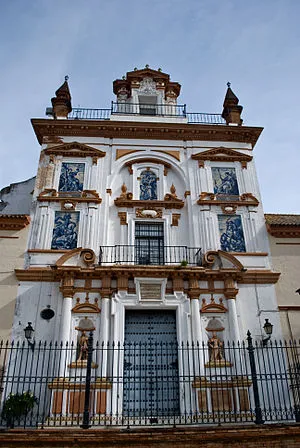
Hospital de la Santa Caridad
A Roman Catholic baroque charity hospital building, dedicated to Our Lady of Charity, founded in 1674 and still caring for the aged and infirm, featuring a chapel with sumptuous baroque sculpture and eight paintings commissioned from Bartolomé Esteban Murillo.

Torre de la Plata
A 13th-century octagonal military tower in Andalusia, constructed by the Almohad Caliphate, was linked by the city wall to another Moorish fortification, the Torre del Oro.
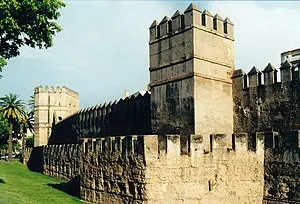
City walls of Seville
City walls of Seville: Expansion in the Islamic period: 9th-12th centuries. The walls were rebuilt and expanded during this period, doubling the city's walled enclosure, with multiple gates and courtyards designed to hinder sieges.
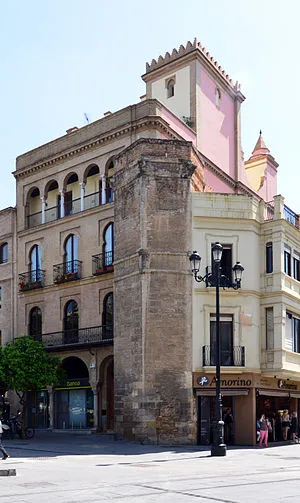
Torre de Abdelazis
A hexagonal Almohade tower in Sevilla, Spain, formerly one of the city's wall vertices connecting to the nearby Real Alcázar palaces. It is also known as Torre del Homenaje, said to be the location where the Castilian flag was first raised after the city's conquest in 1248.
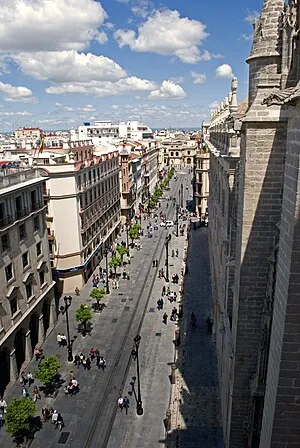
Avenida de la Constitución
Avenida de la Constitución is a 600-meter-long avenue in the historic Casco Antiguo district of Seville, Spain, connecting Puerta de Jerez to Plaza Nueva and the Seville City Council building.
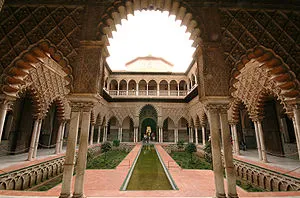
Reales Alcázares
A hydraulic structure, Reales Alcázares is a complex of palaces and gardens built by the Moorish and Gothic monarchs of Spain.

Calle Vida
A street in the city of Sevilla, Spain, that runs from Plaza de Doña Elvira to Calle Agua and appears in the 1771 Olavide plan and historical records of street names.

Antiguo Hospital de Venerables Sacerdotes
A former hospital turned museum, the Antiguo Hospital de Venerables Sacerdotes houses the Velázquez Center, dedicated to the life and works of Diego Velázquez. The center features exhibitions and artwork from the Golden Age of Spanish painting.
Audio Preview
30 secDownload App
Experience this tour and many more with our mobile app. Available for iOS and Android.
Audio Preview
Tour Map
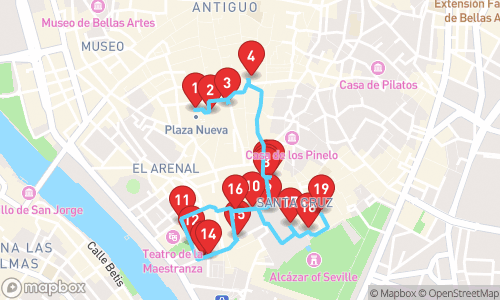
Quick Facts
- ✓GPS-guided navigation
- ✓Professional audio narration
- ✓Offline maps available
- ✓Premium content included
Why Choose This Tour
Expert Local Guide
Narrated by Jenny Multilingual, specializing in general tourism
Flexible Timing
Take the tour at your own pace, any time of day
